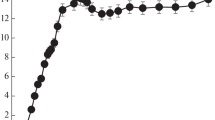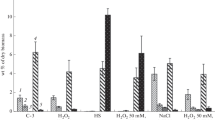Abstract
Based on the observation that shocks provoked by heat or amphiphilic compounds present some similarities, this work aims at studying whether cells grown on oleate (amphiphilic pre-stress) acquire a tolerance to heat shock. In rich media, changing glucose for oleate significantly enhanced the cell resistance to the shock, however, cells grown on a minimal oleate medium lost their ability to grow on agar with the same kinetic than glucose-grown cells (more than 7-log decrease in 18 min compared with 3-log for oleate-grown cells). Despite this difference in kinetics, the sequence of events was similar for oleate-grown cells maintained at 50°C with a (1) loss of ability to form colonies at 27°C, (2) loss of membrane integrity and (3) lysis (observed only for some minimal-oleate-grown cells). Glucose-grown cells underwent different changes. Their membranes, which were less fluid, lost their integrity as well and cells were rapidly inactivated. But, surprisingly, their nuclear DNA was not stained by propidium iodide and other cationic fluorescent DNA-specific probes but became stainable by hydrophobic ones. Moreover, they underwent a dramatic increase in membrane viscosity. The evolution of lipid bodies during the heat shock depended also on the growth medium. In glucose-grown cells, they seemed to coalesce with the nuclear membrane whereas for oleate-grown cells, they coalesced together forming big droplets which could be released in the medium. In some rare cases of oleate-grown cells, lipid bodies were fragmented and occupied all the cell volume. These results show that heat triggers programmed cell death with uncommon hallmarks for glucose-grown cells and necrosis for methyl-oleate-grown cells.





Similar content being viewed by others
References
Aguedo M, Beney L, Waché Y, Belin J-M, Gervais P (2002) Interaction of odorous lactones with phospholipids: implications in toxicity towards producing yeast cells. Biotechnol Lett 24:1975–1979
Aguedo M, Beney L, Waché Y, Belin J-M (2003a) Interaction of an odorant lactone with model phospholipid bilayers and its strong fluidizing action in yeast membrane. Int J Food Microbiol 80:211–215
Aguedo M, Beney L, Waché Y, Belin J-M (2003b) Mechanisms underlying the toxicity of lactone aroma compounds towards the producing yeast cells. J Appl Microbiol 94:258–265
Aguedo M, Waché Y, Mazoyer V, Sequeira-Le Grand A, Belin J-M (2003c) Increased electron donor and electron acceptor characters enhance the adhesion between oil droplets and cells of Yarrowia lipolytica as evaluated by a new cytometric assay. J Agric Food Chem 51:3007–3011
Aguedo M, Waché Y, Coste F, Husson F, Belin J-M (2004) Impact of surfactants on the biotransformation of methyl ricinoleate into gamma-decalactone by Yarrowia lipolytica. J Mol Catal 29:31–36
Artwohl M, Lindenmair A, Sexl V, Maier C, Rainer G, Freudenthaler A, Huttary N, Wolzt M, Nowotny P, Luger A, Baumgartner-Parzer SM (2008) Different mechanisms of saturated versus polyunsaturated FFA-induced apoptosis in human endothelial cells. J Lipid Res 49:2627–2640
Balzan R, Sapienza K, Galea DR, Vassallo N, Frey H, Bannister WH (2004) Aspirin commits yeast cells to apoptosis depending on carbon source. Microbiology 150:109–115
Bedner E, Burfeind P, Gorczyca W, Melamed MR, Darzynkiewicz Z (1997) Laser scanning cytometry distinguishes lymphocytes, monocytes, and granulocytes by differences in their chromatin structure. Cytometry 29:191–196
Bedner E, Li X, Gorczyca W, Melamed MR, Darzynkiewicz Z (1999) Analysis of apoptosis by laser scanning cytometry. Cytometry 35:181–195
Büttner S, Eisenberg T, Herker E, Carmona-Gutierrez D, Kroemer G, Madeo F (2006) Why yeast cells can undergo apoptosis: death in times of peace, love, and war. J Cell Biol 175:521–525
Cao-Hoang L, Marechal PA, Le-Thanh M, Gervais P, Waché Y (2008) Fluorescent probes to evaluate the physiological state and activity of microbial biocatalysts: a guide for prokaryotic and eukaryotic investigation. Biotechnol J 3:890–903
Deere D, Shen J, Vesey G, Bell P, Bissinger P, Veal D (1998) Flow cytometry and cell sorting for yeast viability assessment and cell selection. Yeast 14:147–160
Feng Z, Zhang J-t (2004) Protective effect of melatonin on β-amyloid-induced apoptosis in rat astroglioma c6 cells and its mechanism. Free Radic Biol Med 37:1790–1801
Gaspar ML, Jesch SA, Viswanatha R, Antosh AL, Brown WJ, Kohlwein SD, Henry SA (2008) A block in endoplasmic reticulum-to-Golgi trafficking inhibits phospholipid synthesis and induces neutral lipid accumulation. J Biol Chem 283:25735–25751
Gómez-Muñoz A, Kong JY, Parhar K, Wang SW, Gangoiti P, González M, Eivemark S, Salh B, Duronio V, Steinbrecher UP (2005) Ceramide-1-phosphate promotes cell survival through activation of the phosphatidylinositol 3-kinase/protein kinase B pathway. FEBS Lett 579:3744–3750
Groguenin A, Waché Y, Escamilla Garcia E, Aguedo M, Husson F, LeDall M-T, Nicaud J-M, Belin J-M (2004) Genetic engineering of the β-oxidation pathway in the yeast Yarrowia lipolytica to increase the production of aroma compounds. J Mol Catal 28:75–79
Jenkins GM (2003) The emerging role for sphingolipids in the eukaryotic heat shock response. Cell Mol Life Sci 60:701–710
Jones DL, Petty J, Hoyle DC, Hayes A, Oliver SG, Riba-Garcia I, Gaskell SJ, Stateva L (2004) Genome-wide analysis of the effects of heat shock on a Saccharomyces cerevisiae mutant with a constitutively activated cAMP-dependent pathway. Comp Funct Genomics 5:419–431
Kaiser RD, London E (1998) Location of diphenylhexatriene (DPH) and its derivatives within membranes: comparison of different fluorescence quenching analyses of membrane depth. Biochemistry 37:8180–8190
Madeo F, Fröhlich E, Fröhlich KU (1997) A yeast mutant showing diagnostic markers of early and late apoptosis. J Cell Biol 139:729–734
Madeo F, Herker E, Wissing S, Jungwirth H, Eisenberg T, Fröhlich KU (2004) Apoptosis in yeast. Curr Opin Microbiol 7:655–660
Ouvry A, Waché Y, Tourdot-Maréchal R, Diviès C, Cachon R (2002) Effects of oxidoreduction potential combined with acetic acid, NaCl and temperature on the growth, acidification, and membrane properties of Lactobacillus plantarum. FEMS Microbiol Lett 214:257–261
Pebay-Peyroula E, Dufourc EJ, Szabo AG (1994) Location of diphenyl-hexatriene and trimethylammonium-diphenyl-hexatriene in dipalmitoylphosphatidylcholine bilayers by neutron diffraction. Biophys Chem 53:45–56
Piper PW (1995) The heat shock and ethanol stress responses of yeast exhibit extensive similarity and functional overlap. FEMS Microbiol Lett 134:121–127
Riezman H (2004) Why do cells require heat shock proteins to survive heat stress? Cell Cycle 3:61–63
Romero-Guido C, Belo I, Ta TMN, Cao-Hoang L, Alchihab M, Gomes N, Thonart P, Teixeira JA, Destain J, Waché Y (2011) Biochemistry of lactone formation in yeast and fungi and its utilisation for the production of flavour and fragrance compounds. Appl Microbiol Biotechnol 89:535–547
Sá-Correia I, Salgueiro SP, Viegas CA, Novais JM (1989) Leakage induced by ethanol, octanoic and decanoic acids in Saccharomyces cerevisiae. Yeast 5:S123–S127
Subczynski WK, Wisniewska A (2000) Physical properties of lipid bilayer membranes: relevance to membrane biological functions. Acta Biochim Pol 47:613–625
Ta TMN, Cao-Hoang L, Phan-Thi H, Tran HD, Souffou N, Gresti J, Marechal PA, Cavin JF, Waché Y (2010) New insights into the effect of medium chain length lactones on yeast membranes. Importance of the culture medium. Appl Microbiol Biotechnol 87:1089–1099
Tolner B, Poolman B, Konings WN (1997) Adaptation of microorganisms and their transport systems to high temperatures. Comp Biochem Physiol A Physiol 118:423–428
van de Vossenberg JL, Driessen AJ, da Costa MS, Konings WN (1999) Homeostasis of the membrane proton permeability in Bacillus subtilis grown at different temperatures. Biochim Biophys Acta 1419:97–104
Waché Y, Laroche C, Bergmark K, Møller-Andersen C, Aguedo M, Le Dall MT, Wang H, Nicaud J-M, Belin J-M (2000) Involvement of acyl coenzyme A oxidase isozymes in biotransformation of methyl ricinoleate into γ-decalactone by Yarrowia lipolytica. Appl Environ Microbiol 66:1233–1236
Waché Y, Aguedo M, Choquet A, Gatfield IL, Nicaud J-M, Belin J-M (2001) Role of β-oxidation enzymes in γ-decalactone production by the yeast Yarrowia lipolytica. Appl Environ Microbiol 67:5700–5704
Weber FJ, de Bont JA (1996) Adaptation mechanisms of microorganisms to the toxic effects of organic solvents on membranes. Biochim Biophys Acta 1286:225–245
Acknowledgements
This work was partially funded by the French Agency for Research (programme Transaronat). A grant was given to Ta by the French Ministry for Research and to Phan-Thi by the Agence Universitaire de la Francophonie. An important part of the work was carried out in the Spectral Imaging Platform of IFR 92. The authors are thankful to Christine Bernard-Rojas for technical help.
Author information
Authors and Affiliations
Corresponding author
Additional information
Ta and Cao-Hoang contributed equally to this work.
Rights and permissions
About this article
Cite this article
Ta, T.M.N., Cao-Hoang, L., Romero-Guido, C. et al. A shift to 50°C provokes death in distinct ways for glucose- and oleate-grown cells of Yarrowia lipolytica . Appl Microbiol Biotechnol 93, 2125–2134 (2012). https://doi.org/10.1007/s00253-011-3537-3
Received:
Revised:
Accepted:
Published:
Issue Date:
DOI: https://doi.org/10.1007/s00253-011-3537-3




